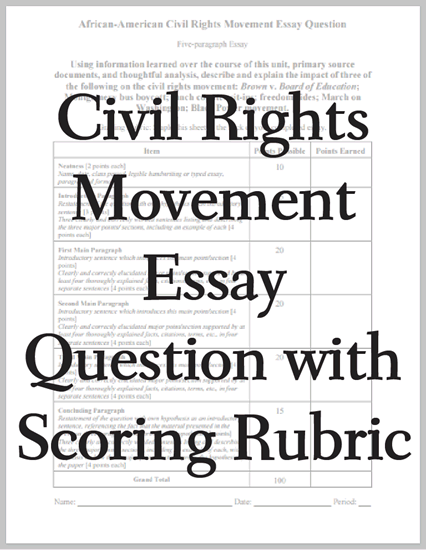African-American Civil Rights Movement Essay Question |
|---|
| www.studenthandouts.com > U.S. History > Decades of Change > Miscellaneous |
 |  |
|---|
Using information learned over the course of this unit, primary source documents, and thoughtful analysis, describe and explain the impact of three of the following on the civil rights movement: Brown v. Board of Education; Montgomery bus boycott; lunch counter sit-ins; freedom rides; March on Washington; Black Power movement. Click here to print (PDF file). Answers will vary. |
|---|
|
Lunch counter sit-ins were a powerful form of nonviolent protest that had a significant impact on the civil rights movement in the United States. These sit-ins, which primarily took place in the early 1960s, were a response to racial segregation and discrimination, particularly in restaurants and other public facilities.
Challenging Segregation: Lunch counter sit-ins were a direct challenge to the racially discriminatory policies and practices that enforced segregation. African American protesters, often college students, would peacefully occupy seats at "whites-only" lunch counters, refusing to leave until they were served. Nonviolent Resistance: Sit-ins were rooted in the principles of nonviolent resistance, following the teachings of civil rights leaders like Martin Luther King Jr. and Mahatma Gandhi. Participants remained peaceful and composed, even in the face of verbal and physical abuse from segregationist counter-protesters. Media Coverage: The sit-ins gained significant media attention, both nationally and internationally. Photographs and news reports showing peaceful black protesters being subjected to violence and arrests struck a chord with many people, generating sympathy and support for the civil rights movement. Legal and Policy Changes: As a result of the increased attention and pressure from the sit-ins, many establishments, particularly in the South, began to desegregate their facilities. This was not only due to moral considerations but also economic ones, as businesses did not want to lose customers and face boycotts. Inspiration: The success of the lunch counter sit-ins inspired other forms of nonviolent protest, including freedom rides, voter registration drives, and the larger civil rights movement. It demonstrated the effectiveness of nonviolent resistance in the face of oppression. Influence on Legislation: The civil rights movement, energized in part by the sit-ins, led to significant federal legislation, including the Civil Rights Act of 1964 and the Voting Rights Act of 1965. These laws outlawed racial discrimination in public facilities, schools, employment, and voting. Solidarity and Coalition Building: The sit-ins also promoted a sense of unity and solidarity among civil rights activists and organizations. They brought together individuals from different backgrounds and ideological perspectives under the common goal of ending segregation and racial discrimination. Symbol of Change: The lunch counter sit-ins remain a symbol of the civil rights movement and its commitment to justice, equality, and social change. They are commemorated as a pivotal moment in the struggle for civil rights in the United States. Lunch counter sit-ins were instrumental in challenging and eventually dismantling segregation in public places. They demonstrated the power of nonviolent resistance, garnered widespread attention, and contributed to the broader civil rights movement's success in achieving legal and social change in the United States. |
| www.studenthandouts.com > U.S. History > Decades of Change > Miscellaneous |









